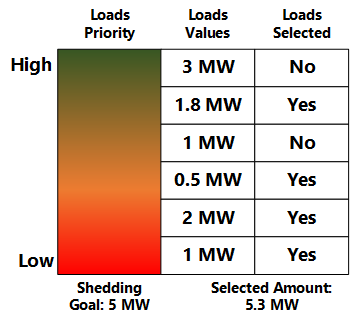The next figure presents a flowchart of Elipse Power's Load Shedding functionality. The following text contains a description of each step on this flowchart.

Load Shedding flowchart
Scan of Electrical Measurements
Sample of active power Measurements of Generators and Breaker statuses. This reading is performed via communication protocol using a connection with PLCs.
Build a System Snapshot
Snapshot of the current situation of the system, which is used as an input to perform event simulations.
Electrical Model
System's electrical model regarding the registration of Switches, Breakers, Generators, Loads, Bars, Transformers, and electrical connections between them.
Registered Scenarios
Registration of events that may unbalance the system. It supports generation-loss events, trips in tie breakers, load relief, etc.
Simulation of Scenarios
For each user-defined Scenario, there is a simulation on the impact of events occurring in this Scenario. This simulation is performed by identifying the system topology (post-event) and executing a power flow for each island of this topological model. Based on the analysis of power flow results, deficiencies of generation and overloads are identified.
Calculate the Amount to Shed
During the step to evaluate the amount to shed, the power flow result of the Scenario simulation step is used to check if there are deficiencies of generation in the system. If there are deficiencies, then the algorithm calculates the amount of load to shed for each island, according to the equation on the next figure.

Equation to calculate the amount to shed
The components of this equation are described on the next table.
Components of the calculation of the amount to shed
Component |
Description |
|---|---|
 |
Active power to shed in the island j for the Scenario τ |
 |
Active power of Generator i calculated in the power flow for Scenario τ |
 |
When the SpinningReserveMode property is equal to (zero), considers the spinning reserve of the most robust generation unit. When the SpinningReserveMode property is equal to 1 (one), indicates the spinning reserve of the generation unit i |
 |
Active power measured of Generator i |
Calculate the Loads to Shed
If the step of evaluating the Scenario identify deficiencies of generation, then a selection of blocks of load to shed is performed. The criteria used for selecting these blocks is the active power to shed in each island, Breakers available for shedding, and priorities configured for each load. Then an optimization algorithm is performed, to select the best set of loads with low priority whose sum is greater than the amount that must be shed, so that there is no deficiency of generation if this Scenario occurs. During this process of optimization, some low priority loads may be kept, according to the next example.

Calculation of loads that must be shed
By analyzing the previous figure, users can verify that the 1 MW load was spared, although it has a priority lower than the 1.8 MW. The optimization algorithm performs that to avoid unnecessary shut downs of loads, because an excessive relief may also cause a system instability.
Calculate the Breakers that must be Preset for this Scenario
Once all loads that must be shed are identified, the Breakers that must operate if this simulated Scenario occurs are also identified. These Breakers are loaded to a buffer for a later preset writing to PLCs via communication protocol.
Send Preset Commands
Execution of preset writings to PLCs via communication protocol.